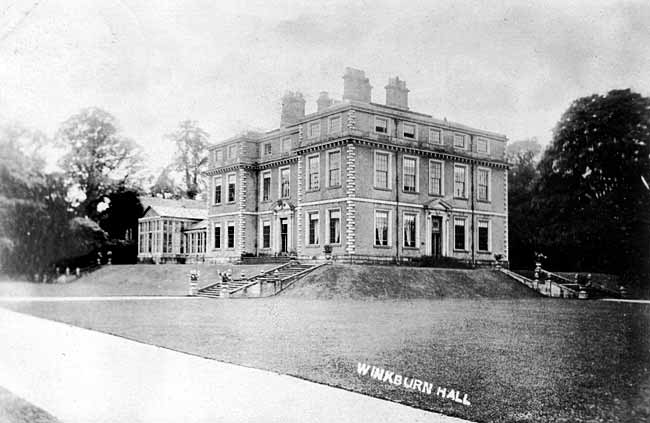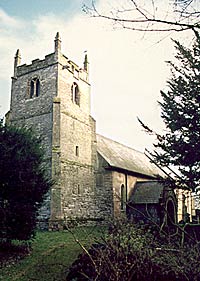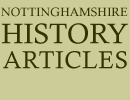
The Hall from the garden front, c.1905.
The church probably stands on the site of the original church mentioned in the earliest records and a fine Norman archway leads to the tower which has much ancient stonework and houses the massive iron-bound vestment chest of other days. A panel in the face toward the hall is framed with geometrical chip carving with a small medallion of a saint in the bottom border; the filling is no more, but a later inset stone bears the inscription: "New built Ano Domi 1672. William Baylis, Thomas Ward."
The archway at the principal entrance was thought to be Danish work and has curious carved heads of Vikings and dogs.
The carved Jacobean pulpit is a three-decker and there are the old high pews, one of which, with carved balustrade, was the minister's pew.
The three bells in the tower are dated 1633, and there is a record that one of them was loaned to Southwell Minster while their bells were being recast.
The Burnell family endowed the school at Winkburn with an estate at Upton and the surrender for the lands is dated the 26th July, 1740, and signed by Edward Becher, Steward to the Manor of Southwell.
 The village school.
The village school.The lands are given to Benjamin Clay, gentleman, and James Gibson, clerk, in trust to apply the rents for finding a schoolmaster to teach twelve poor boys or girls of the Parish of Winkburn, which said master and children are to be nominated by William Burnell and his heirs for ever, to read English, write, and cast accounts and to instruct them in the principles of the Christian religion.
A picturesque old house in the village was allotted to the use of the schoolmaster, to which class-rooms have been added and the school is carried on here, at the present time, under the Educational Authorities.
After nine generations at Winkburn, the Burnell family became extinct in the male line on the death, in 1774, of Darcy Burnell, whose initials, with the date 1770, appear on the capacious lead cistern by the church porch.
His widow had the manor for her life, but numerous claims were made by persons claiming to be the heirs-at-law of Darcy Burnell.
The Court of Chancery directed an issue to be tried and the trial was held in 1781 at Nottingham before Mr. Baron Hotham and a special Jury, when it was found that Peter Pegge of Beauchief Abbey and Catherine Wombwell of Womb well were the co-heirs by descent from daughters of William Burnell, the second owner, who died in 1609.

Winkburn Church (photo: A Nicholson, 1988).
Catherine Wombwell having withdrawn her claim, Peter Pegge obtained a decree from the Lord Chancellor that he was entitled to the estates and, in accordance with the will, took the name and arms of Burnell, but a new claimant then appeared in the person of Richard Bristowe of Beesthorpe, also a descendant of a daughter of the second owner.
He proved his claim at the Spring Assizes in Nottingham in 1785, but was non-suited on a technical point of law. On appeal to the Court of King's Bench, the technical point was over-ruled and Richard Bristowe became a co-heir and assumed the name and arms of Burnell.
Richard Bristowe Burnell having died and left his estates to his widow, she, in 1791, was re-married to John Kinderley, and in 1813 they sold their half moiety of Winkburn to Peter Pegge Burnell, who thus became sole owner and lived to enjoy the estates until 1836 when he died, childless, at the age of 85, and has a monument in Winkburn Church.
He was succeeded by his nephew, Broughton Steade, who assumed the name and arms of Pegge-Burnell.
His son and grandsons followed him until February of 1931, when the family vault in the chancel of the church was opened to receive the remains of the last surviving grandson, who had assumed the name of Smith-Milnes on succeeding to an estate in Derbyshire.
He died without issue and under his will and an order of the Court of Chancery, the Manor of Winkburn has passed to Assheton Craven Smith-Milnes, a descendant of a daughter of Broughton Pegge Burnell.
